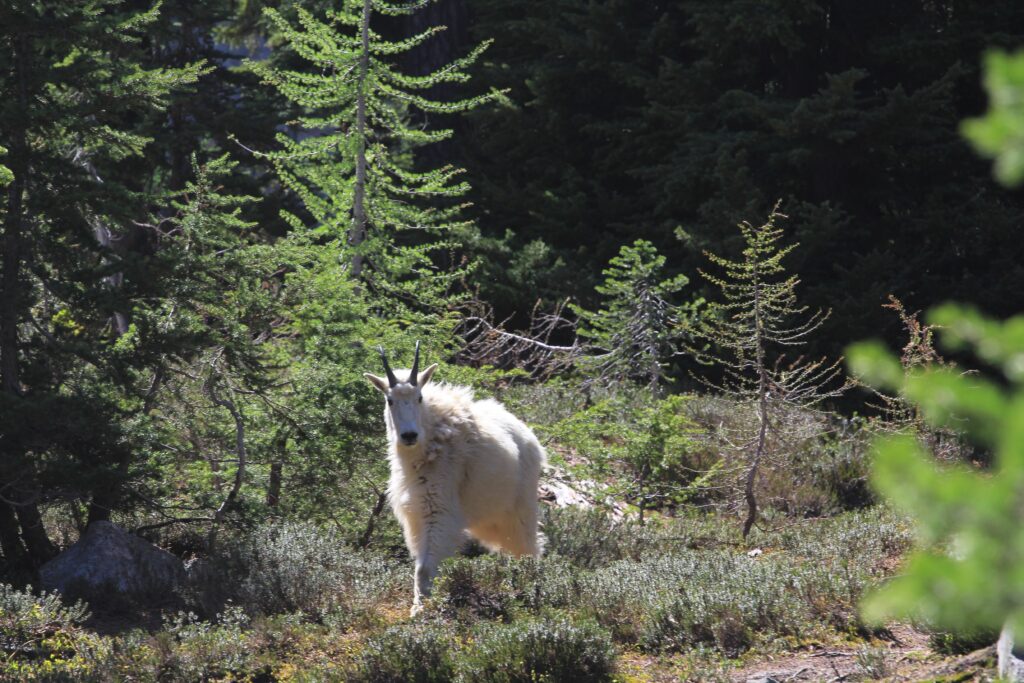When I was a naturalist working in South Carolina, I met a few invasive animal species that did not win over many fans. The ugly look and destructive behavior of feral hogs, the irritating sting of fire ants, and the bluebird-killing tendencies of starlings and house sparrows means that most people, let alone wildlife fans, would be happy to rid the ecosystem of them. But there is a lot to admire in the Mountain Goat, Oreamnos americanus. One of the most charismatic animals in North America, they win over a host of admirers by picking their way across the most challenging alpine terrain in the Greater Yellowstone Ecosystem.
While most of our local hooved animals migrate to lower elevation habitats in the winter, mountain goats remain year-round on their cliff habitat. To survive temperatures below -40 F, they grow wooly white winter fur so thick – 8” – that you could bury your hand to the wrist and still not touch goat with your fingers! To grip on the precarious icy slopes, mountain goats have hooves that function as suction cups, with a hard exterior and a rubbery concave interior. This behavior makes them nearly invulnerable to predators – few other animals can tackle such an extreme terrain and climate. Golden eagles have been known to knock kids off cliffs, but once they grow too large, the most likely causes of mountain goat mortality are falls and avalanches.
In both Yellowstone and Grand Teton National Parks, mountain goats are seen year-round in expanding numbers. Unfortunately, they are not native to either park. Introduced to nearby mountain ranges primarily for hunting, they arrived in Grand Teton by the 1980s and Yellowstone by the 1990s. From a small handful, they have expanded to over a hundred in Grand Teton National Park and two hundred in Yellowstone. Viewing mountain goats through our Maven spotting scopes is always a highlight of one of our Yellowstone multi-day tours. We often hear exclamations of wonder at their ability to navigate the slopes that few other animals dare tread, and amazement that they can survive off the few plants that grow in the bleak alpine habitat. So why are they such a problem?

The main concern is the effect of competition with the native bighorn sheep. Mountain goats are larger and more muscular than bighorns, able to displace them from their habitat and compete for the limited forage available at high altitude. They are a disease vector to a population that already struggles with diseases passed to the herd from domestic livestock. Grand Teton’s herd of bighorn sheep, already isolated from other sheep by development, has declined from 150 in 2013 to roughly 80 in 2019. In those years, mountain goats rose from around a dozen to over 100. Mountain goats are not the only cause of the bighorn sheep decline, but they may be speeding up the loss, and possible future extinction, of this equally charismatic and ecologically important native species.
Currently, the Wyoming Game and Fish Department manages the goats as big game with an annual hunting season and the Park Service has a policy of removing exotics, particularly those that pose an imminent threat to native species or systems. While both strategies have been controversial due to the charisma and tenacity these goats put on display for the avid wildlife viewer, it seems the threat may be too large to ignore and it may be time for these tough, shaggy goats to return to their native range.
Interested in learning more from a Wildlife Expeditions guide?
This post was guest written by Wildlife Expeditions guide, Sarah Ernst. Sarah is a passionate educator that has been guiding for Wildlife Expeditions since 2011. She loves using stories, science, and dialogue to help her guests learn, connect, and form a deeper relationship with the national parks as well as their own home ecosystem. She received her Bachelor of Arts in Philosophy from Mount Holyoke College in South Hadley, MA in 2005. Prior to arriving in Jackson Hole, Sarah was the Education and Exhibits Coordinator at Kiawah Island Nature Center in South Carolina. In her free time Sarah enjoys exploring the Greater Yellowstone Ecosystem with hiking boots, kayaks, skis, and snowshoes – usually accompanied by her loyal dog Linus.


